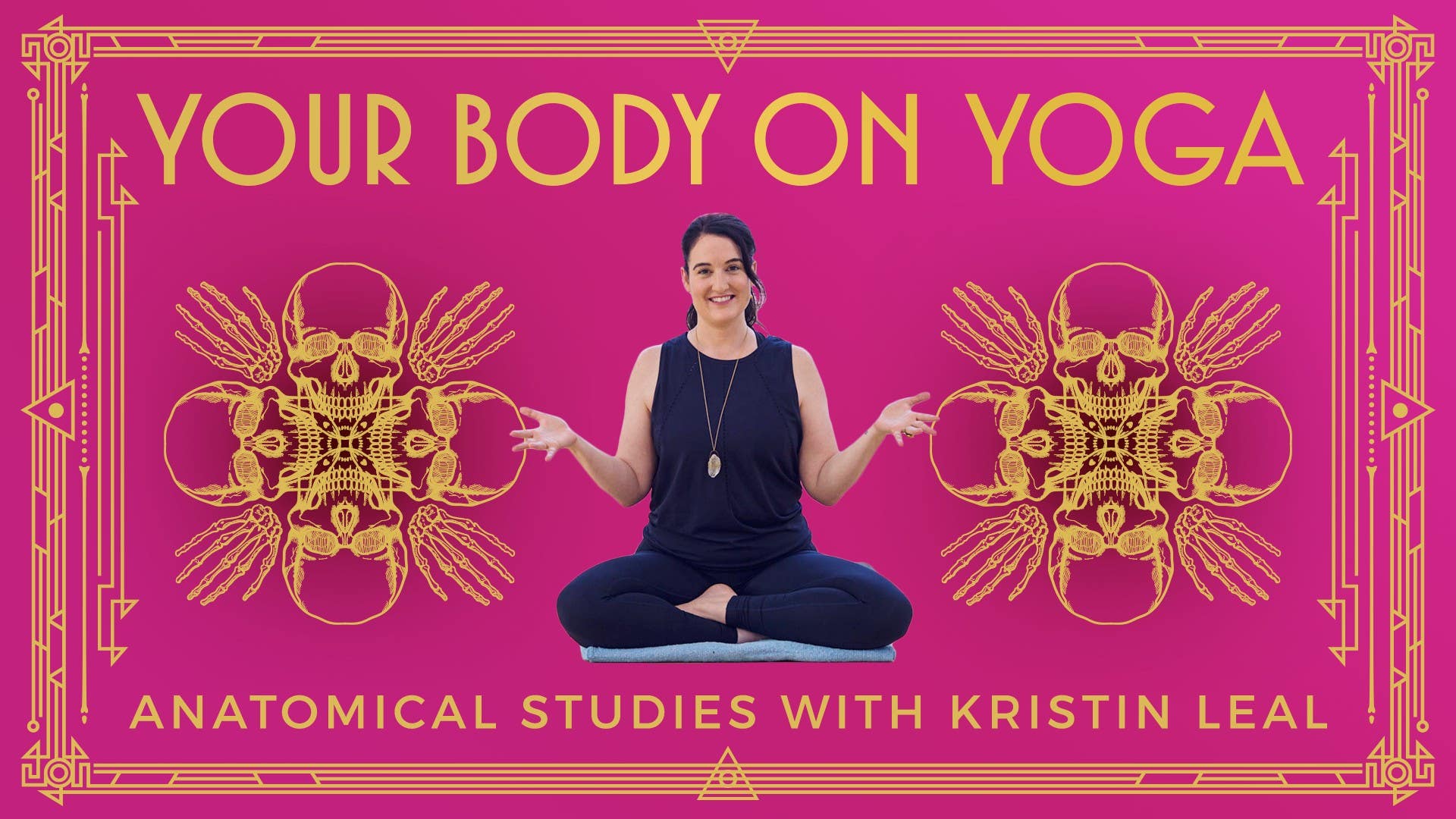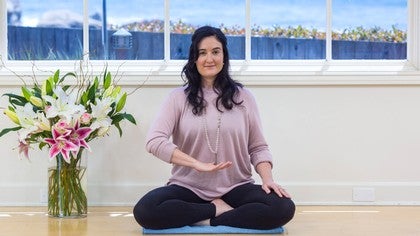Description
Please see attached .pdf to go along with this lesson.
About This Video
Transcript
Read Full Transcript
We all have access to a constant companion, an ever-present teacher, a teacher that visits us tens of thousands of times a day, a teacher who can excite us or calm us, a teacher that by her entering caresses our heart and by her exit makes us softer, a teacher who we can engage with or ignore. And this teacher, of course, is the breath. And I think that a lot of us coming into a yoga practice have a very limited view of the breath. We basically think it's just this exchange of oxygen and carbon dioxide, which of course it is, a very important part of the picture. But when we can really fully inhabit the full reach of the breath into our body as well as into our lives, it can become a truly transformational teacher.
So I think we've lost this understanding in our current era, but if we look back many different languages over many different cultures would have the same word for breath as well as soul, as well as spirit. In the Latin anima spiritus, meaning both breath and spirit, in the Greek psychinuma, soul and air, even in the Chinese language, the three characters that make up the word breath mean of the conscious self or heart, quite beautiful. Even in our own English cliches, like she took my breath away or he was a breath of fresh air, we know on some intuitive level that the breath and the mind and the body and our energies, maybe even spirit, are inextricably linked. We know this on a cellular level because if you've ever been running late for a train and you have to get somewhere and you're super late, you'll start to notice that your body will start to fidget, your breath will get kind of short and sharp and kind of up into the upper reaches of your lungs, your mind will begin to race. And it's not like you think that those things are going to help the train come quicker, but it's something that just automatically happens.
Or if you find yourself really focused or maybe if that's revved up to 20, angry. You have a laser point focus. Your breath starts to go into the side reaches of your ribs, almost like a bowl breathing. Your mind is just sharp on one event. And again, your body clenching, that's not going to help the situation or it's not something that you're doing maybe consciously, but we all do it.
Even maybe when you get home after a long day of work and you finally get to put your bag down and you slump down into your couch, you get all kind of snuggly, your breath moves into your lower belly, your skin softens. This is just, they're linked and there's no doubt about it. And the ancient yogis knew this, felt this, discovered this and tried to reverse engineer these practices or these technologies to bring about a certain energetic, emotional or physical state. Let's look at the anatomy of the breath and we can start to see that there's a really beautiful poetry to it. So first things first, the prime mover of respiration is our thoracic diaphragm.
And the thoracic diaphragm, this muscle, is a mushroom cap or like a portobello mushroom to the exact shape. And it's kind of tucked up underneath the last six ribs on either side. And it has a center tendon and then two little tendrils, almost like the tethers that come off of an open parachute. There's two little tethers that reach down into the upper lumbar spine. And as we might have learned earlier, it's actually continuous with that psoas muscle that attaches to our upper thigh bones.
So when the body wants to inhale, and this can happen either voluntarily, like I could ask you right now, take a deep breath, I'll wait. Then you take a deep breath or it happens automatically or autonomically. So you've been breathing this whole time without me asking that of you. Either way, voluntarily or autonomically, happens the same way. Nerve that enters the diaphragm is stimulated.
The diaphragm begins to contract. And as it contracts, it draws down towards the earth, towards the floor. Now this creates a negative pressure in the chest. Air loves to move to the area of lowest pressure. So air will be funneled in through the nose or the mouth or whatever's open.
This is a much more yogic expression or understanding of the breath than I first had. I very much thought that we kind of sniffed the breath in and pushed the breath out and quite active, but it's much more poetic. We are literally just creating space for the inspiration to fill us. Much more beautiful approach. Now as the body is ready to exhale, the diaphragm just relaxes back into its kind of open umbrella shape and that helps to passively facilitate the movement of the breath out.
So first things first, that diaphragm moves, initiates this inspiration and expiration. We even get some real beauty from those words. To inspire is the fancy way of saying inhalation. These inspirations, when life began with inhalation, your time on this plane of existence began with this first breath. And it actually was quite a powerful breath, so think back.
When you were inside your mother, your circulatory system was just reversed pretty much. Your heart instead of being this four-chambered mansion was actually just kind of in two parts with a hole in the center for the blood to pass. The arteries which in our adult bodies now are carrying oxygen-rich blood and our veins are carrying oxygen-depleted blood, it's actually reversed in utero. Your arteries are carrying the deficient of oxygen blood and your veins are carrying the oxygen-rich blood. Your lungs are not really doing the breathing in utero.
They're mostly filled with fluid and deflated because you're taking all of the exchange from the umbilical cord to the placenta to your mom. Now when you come out, quite a shock. When you come out, that's you coming out, when you come out, the shock of this new world makes you go, this engagement, this inspiration, this is the first time the air is entering your lungs. In that moment, the lungs inflate for the first time, the hole between the heart begins to seal your very first scar and the whole circulatory system reverses, all in that one breath, arguably the most important breath or inhale that you've ever taken. Now if you've ever been with someone at the moment of their passing, you might notice that life on this plane ends with a exhalation or the fancier term, expiration.
So this concept of engagement and surrender, inhale and exhale, inspiration, expiration is bookending our lives here. And by tapping into that power in our practice, we can tap into those concepts. As we inhale and the diaphragm descends, breath is funneled in through the nostrils. Now back behind the nostrils, they're warmed and filtered and moistened to make the breath more suitable for the body. It bounces off the walls of the inner bones of the face, these little caverns and nooks and crannies creating more turbulence, more warmth, more heating, more filtering.
It takes a little 90 degree turn down the pharynx, down through the larynx and then there's a little kind of flap called the epiglottis which can be found there to prevent food moving down through the wrong tube. There'll be a tube then branching off for the food called the esophagus but a branch for anterior to that called the trachea. The trachea then branches off into two bronchial tubes into almost like upside down trees. All of these branches, tens of thousands of branches called the bronchials begin to branch off and fill the tissue of the lungs. At the end of those teeny tiny little branches, there's like almost like a little cluster of grapes.
It looks very similar to a dollhouse set of grapes. And then that level, the alveoli, this is where the exchange of oxygen and carbon dioxide happen. Now keeping our view large, it is the cells that are desirous of the breath, even the cell on your pinky finger or all the way down into your foot, these cells are desirous of the exchange of oxygen and carbon dioxide, this exchange of taking in and letting go. As we begin to reconnect to the power and the potential that this breath holds, we can move into a fuller expression, not just in our practice, but in our lives.
Your Body on Yoga: Anatomy of Breath & Heart
Comments
You need to be a subscriber to post a comment.
Please Log In or Create an Account to start your free trial.












